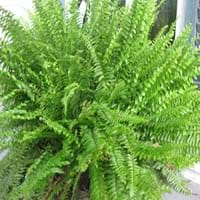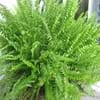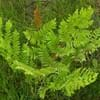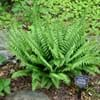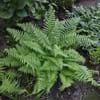Life Span
Perennial
Annual and Perennial
Type
Fern
Tender Perennial
Origin
Mexico, Central America, South America, Brazil, Africa, Middle Africa, Polynesia
South Africa
Types
Nephrolepis biserrata, Nephrolepis cordifolia, Nephrolepis multiflora
Osteospermum acanthospermum, Osteospermum amplectens, Osteospermum burttianum
Habitat
Forests, Humid climates, Swamps
Coastal Regions, Sandy areas, Terrestrial
USDA Hardiness Zone
10-15
10-11
AHS Heat Zone
12-1
Not Available
Sunset Zone
H1, H2, 23, 24
8, 9, 12, 13, 14, 15, 16, 17, 18, 19, 20, 21, 22, 23, 24
Habit
Clump-Forming
Clump-Forming
Flower Color
Not Available
White, Purple, Blue Violet
Flower Color Modifier
Bicolor
Bicolor
Fruit Color
Not Available
Not Available
Leaf Color in Spring
Green
Green
Leaf Color in Summer
Green
Green
Leaf Color in Fall
Green
Green, Blue Green
Leaf Color in Winter
Green
Light Green
Leaf Shape
Irregular
Irregular
Plant Season
Spring, Summer, Fall, Winter
Spring, Summer, Fall
Sunlight
Full Shade, Partial shade
Full Sun, Partial Sun
The pH of Soil
Acidic, Neutral
Neutral
Soil Drainage
Average
Well drained
Bloom Time
Not Available
Late Spring, Early Summer, Summer, Late Summer, Early Fall, Fall
Tolerances
Not Available
Drought
Where to Plant?
Container, Ground, Pot
Container
How to Plant?
Divison
Seedlings, Stem Cutting
Plant Maintenance
Medium
Medium
Watering Requirements
Average Water Needs, Requires regular watering
Do Not over Water, Keep ground moist
In Summer
Lots of watering
Lots of watering
In Spring
Moderate
Moderate
In Winter
Average Water
Average Water
Soil pH
Acidic, Neutral
Neutral
Soil Drainage Capacity
Average
Well drained
Sun Exposure
Full Shade, Partial shade
Full Sun, Partial Sun
Pruning
Remove damaged leaves, Remove dead leaves, Remove dead or diseased plant parts
Remove damaged leaves, Remove dead branches, Remove dead leaves
Fertilizers
All-Purpose Liquid Fertilizer
All-Purpose Liquid Fertilizer
Pests and Diseases
Red blotch
Red blotch
Plant Tolerance
Not Available
Drought
Flower Petal Number
Single
Single
Foliage Texture
Medium
Medium
Foliage Sheen
Not Available
Not Available
Attracts
Hummingbirds
Bees, Birds, Butterflies
Allergy
Erythema, Periungual swelling, Scaling, Vesicles
Not Available
Aesthetic Uses
Hanging Basket, Showy Purposes
Beautification, Showy Purposes
Beauty Benefits
Not Available
Not Available
Edible Uses
Insignificant
No
Environmental Uses
Air purification, Indoor Air Purification
Air purification
Medicinal Uses
Not Available
Not Applicable
Part of Plant Used
Not Available
Flowers
Other Uses
Air freshner, Used as Ornamental plant
Used as Ornamental plant
Used As Indoor Plant
Yes
No
Used As Outdoor Plant
Yes
Yes
Garden Design
Container, Edging, Foundation, Hanging Basket, Mixed Border, Tropical
Bedding Plant, Container, Cutflower, Foundation, Groundcover, Hanging Basket, Mixed Border, Rock Garden / Wall
Botanical Name
NEPHROLEPIS exaltata 'Bostoniensis'
OSTEOSPERMUM fruticosum
Common Name
Boston swordfern, Wild Boston fern, Tuber ladder fern, Fishbone fern
Shrubby Daisybush, Trailing African Daisy
In Hindi
बोस्टन फर्न
पौधा
Blue Eyed Daisy Plant
In German
Boston Fern
Pflanze
Blue Eyed Daisy Pflanze
In French
Boston Fern
Plante
Blue Eyed Daisy Plante
In Spanish
helecho de Boston
Planta
Planta observada azul de la margarita
In Greek
Βοστώνη Fern
Φυτό
Μπλε Eyed Daisy Φυτών
In Portuguese
Boston Fern
Plantar
Planta da margarida de olhos azuis
In Polish
Boston paproci
Roślina
Blue Eyed Daisy roślin
In Latin
Boston Fern
planta
Daisy Blue Eyed Planta
Phylum
Pteridophyta
Magnoliophyta
Class
Filicopsida
Magnoliopsida
Order
Polypodiales
Asterales
Family
Dryopteridaceae
Asteraceae
Genus
Nephrolepis Schott
Osteospermum
Clade
Not Available
Angiosperms, Asterids, Eudicots
Tribe
Not Available
Calenduleae
Subfamily
Not Available
Asteroideae
Properties of Boston Fern and Blue Eyed Daisy Plant
Wondering what are the properties of Boston Fern and Blue Eyed Daisy Plant? We provide you with everything About Boston Fern and Blue Eyed Daisy Plant. Boston Fern doesn't have thorns and Blue Eyed Daisy Plant doesn't have thorns. Also Boston Fern does not have fragrant flowers. Boston Fern has allergic reactions like Erythema, Periungual swelling, Scaling and Vesicles and Blue Eyed Daisy Plant has allergic reactions like Erythema, Periungual swelling, Scaling and Vesicles. Compare all the properties and characteristics of these two plants. Find out which of these plant can be used as indoor plant. If you are interested to decorate your house and garden, find out aesthetic uses, compare them and select the plant which will beautify your surrounding. Along with beautification, try comparing medicinal and edible uses of Boston Fern and Blue Eyed Daisy Plant and you can choose the plant having best and most benefits.
Season and Care of Boston Fern and Blue Eyed Daisy Plant
Season and care of Boston Fern and Blue Eyed Daisy Plant is important to know. While considering everything about Boston Fern and Blue Eyed Daisy Plant Care, growing season is an essential factor. Boston Fern season is Spring, Summer, Fall and Winter and Blue Eyed Daisy Plant season is Spring, Summer, Fall and Winter. The type of soil for Boston Fern is Loam and for Blue Eyed Daisy Plant is Loam while the PH of soil for Boston Fern is Acidic, Neutral and for Blue Eyed Daisy Plant is Neutral.
Boston Fern and Blue Eyed Daisy Plant Physical Information
Boston Fern and Blue Eyed Daisy Plant physical information is very important for comparison. Boston Fern height is 90.00 cm and width 180.00 cm whereas Blue Eyed Daisy Plant height is 36.00 cm and width 51.00 cm. The color specification of Boston Fern and Blue Eyed Daisy Plant are as follows:
Boston Fern flower color: Not Available
Boston Fern leaf color: Green
Blue Eyed Daisy Plant flower color: White, Purple and Blue Violet
- Blue Eyed Daisy Plant leaf color: Green
Care of Boston Fern and Blue Eyed Daisy Plant
Care of Boston Fern and Blue Eyed Daisy Plant include pruning, fertilizers, watering etc. Boston Fern pruning is done Remove damaged leaves, Remove dead leaves and Remove dead or diseased plant parts and Blue Eyed Daisy Plant pruning is done Remove damaged leaves, Remove dead branches and Remove dead leaves. In summer Boston Fern needs Lots of watering and in winter, it needs Average Water. Whereas, in summer Blue Eyed Daisy Plant needs Lots of watering and in winter, it needs Average Water.
